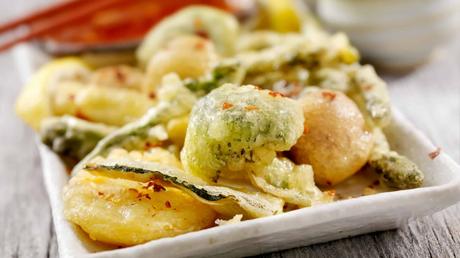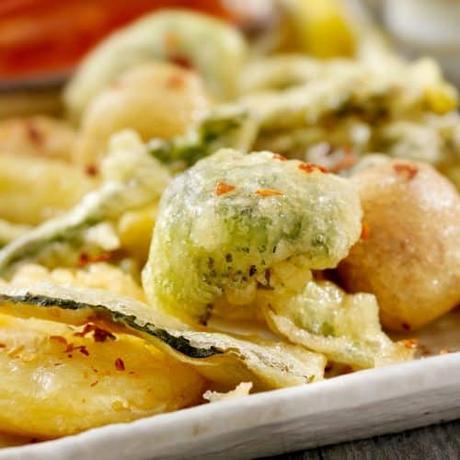Tempura is a popular Japanese dish that is made of battered and deep-fried seafood, meat, and vegetables.
Vegetable tempura, as the name suggests, consists of just vegetables covered in a light, crispy batter and is just as tasty without the meat or seafood.
In this article, we have a great vegetable tempura recipe for you, but that’s not all.

We’ll also take you through our serving suggestions, gluten, and keto free batter alternatives, as well as what to look out for when shopping for those all-important veggies.
Tempura Vegetables
Before we get to the recipe, let’s start with some of the basics like the taste and various uses of tempura vegetables.
Taste
The flavor of your tempura will naturally depend on which vegetables you combine together.
However, as far as the batter is concerned, a thin and delicate but crispy coating is the ideal result.
As the batter heats up and cooks, it will form this coating around your tempura vegetables and stop them from becoming too oily.
Therefore, unlike some other batter-fried foods, tempura generally has a light and fresh taste.
You get nutritious vegetables coated in a juicy-crunchy but clean batter – it’s a win-win.
Uses
Tempura has many uses, and this versatility definitely contributes to its popularity.
You can either serve it as a main dish on its own or make your tempura in combination with several other foods to create alternative Japanese dishes.
For instance, you can serve your tempura on rice as donburi (rice bowl dish), or on top of noodles such as soba (buckwheat noodles).
It is also commonly served as a side with a popular dipping sauce known as tentsuyu.
Or you could even fry sushi rolls in tempura-style batter or create your own ‘tempura rolls’ by wrapping the tempura veg in rice and nori (seaweed).
Why Some Vegetables for Tempura and Not Others
The main thing to remember when picking your vegetables is that you want something that is both dry and easy to cut into bite-size pieces.
With these criteria in mind, the common lineup includes (but is not limited to) carrots, sweet potatoes, eggplant, broccoli, mushrooms, peppers, and zucchini.
It may be slightly more difficult to use leafy greens such as kale or beet greens, but that doesn’t necessarily mean it’s not possible.
Just make sure they’re cut into ‘fry-able’ slices and that they’re dry, otherwise the batter will just slide right off.
Herbs like basil, sage, and rosemary are a no no since they’re not very munchable on their own. However, you could certainly add them to your tempura vegetables as a garnish.
What to Look for in Good Tempura Vegetables
It may seem obvious, but the fresher the vegetables, the fresher the vegetable tempura.
Some signs to look out for that indicate freshness include a bright, lively color.
You should also check that the vegetable is fairly firm and free of any soft spots.
Different vegetables have different harvest seasons. For example, the peak season for sweet potatoes is between October and March.
Therefore, if you’re planning to make your vegetable tempura with sweet potatoes during this period, you already know that it’ll most likely be fresh.
One further perk to this is that vegetables are also more affordable during their harvest season.
Also check out this Delicious & Healthy Japanese Hibachi Vegetable Recipe!
 Print
Print
Tempura Vegetables
Now that we’ve gone through what to consider when picking your vegetables, let’s get right into it. The vegetables in this recipe are recommended for the dish, but you do not have to use them all and can swap them out for other vegetables according to your personal preferences. We'll also look at what you need for that yummy batter. Course Main CourseCuisine JapaneseKeyword Tempura Prep Time 20 minutesCook Time 25 minutes Servings 4 people Author Joost NusselderIngredients
Vegetables
- 1 sweet potato
- 1 eggplant
- 1-2 carrots
- 2 red bell peppers
- 2 king oyster mushrooms
- 200 g broccoli
- 400 g squash e.g. pumpkin
- 8-10 shiso leaves
Batter
- 1 large egg
- 1 cup all purpose flour
- 1 cup cold water
- 1 tbsp. baking powder optional
- 1-2 ice cubes optional, to further cool water
- Oil with a high smoke point extra virgin olive oil, preferably
Instructions
Batter
- Place your water and ice cubes into a glass and let them combine. (If you are already using water that is very cold then you can skip this step.)
- Pour your flour, egg and cold water into a large bowl.
- Stir together until just about combined, but make sure that you don’t over mix. The mixture does not need to be smooth and can be a little lumpy.
Vegetables
- Before you start dipping the vegetables into your batter, make sure that they are all peeled and sliced into thin pieces.
- Lightly coat your vegetable pieces in flour. (This step is optional, but it can help the batter stick to your veg better.)
- Pour oil into a large wok or saucepan until it is one third full, and heat up over a medium-high heat.
- Dip vegetables into the batter one at a time to lightly coat, starting with the root vegetables (any veg that is grown underground).
- Gently shake off any excess batter, as too much batter will make your tempura too crispy on the outside and too mushy on the inside.
- Add your veggie slices to the saucepan a few pieces at a time and begin deep frying. Don’t add too many pieces as this will drop the temperature of the oil.
- Fry root vegetables for 3-4mins and non-root vegetables for 1-2mins, or until the batter is crispy and golden. Turn each piece about halfway to cook both sides.
- Your shiso leaves will fry very fast, so sprinkle a little flour onto the back of the leaves and dip only the back into the batter. Deep fry for 15 seconds.
- Transfer your tempura veg onto a cooling rack or plate lined up with paper towels to remove any excess oil.
- Serve immediately with dipping sauce or as a dish with rice or noodles, and enjoy.
Tempura Vegetables Nutrition
Now let’s look at the nutritional aspects of tempura vegetables.
Calories
A big perk to this recipe is that you don’t have to feel too guilty, since tempura vegetables are definitely a healthier alternative to other fried foods.
Fun fact: one portion of vegetable tempura, as served by Wagamama, contains 384 calories.
But aside from the numbers, the fact that the majority of food content consists of healthy produce certainly offers its own nutritional advantages.
Though this will differ depending on which ingredients you use, vegetables in general are an excellent source of vitamins and minerals.
Frying
Frying is one of the world’s most popular methods of food preparation.
However, when food is fried it can become more calorific since the food absorbs the fats from the oil.
The type of oil you use can therefore determine how much of their nutritional properties the vegetables retain.
Interestingly, one study found that vegetables can stay healthier when fried in extra virgin olive oil.
Tempura Vegetables Dipping Sauce
The traditional Japanese dipping sauce for tempura is referred to as tentsuyu.
This dip is a fantastic serving option with many kinds of tempura, and tempura vegetables are no exception.
Though the recipe can differ depending on the season, the three most common ingredients include dashi, soy sauce, and mirin, with dashi being the most prominent ingredient.
Tempura dipping sauce is not only light and refreshing but incredibly easy to make.
If you want to ramp up its savory umami taste, simply increase the amount of soy sauce you add to the mix.
You could also add a dash of sugar to balance the saltiness.
This subtle sweet flavoring is the perfect final ingredient, letting your tentsuyu complement your tempura like no other.
What to Serve with Tempura Vegetables
As mentioned above, tentsuyu is undoubtedly the best dipping sauce to be served with tempura vegetables.
Another popular pairing is steamed or fried rice, a classic among Japanese cuisine in general.
This common dish is referred to as tendon tempura and comes in a rice bowl with the fried tempura vegetables served over the rice.
The same can be done with noodles, with the rice being substituted for either udon or soba (buckwheat) noodles and the tempura once again served on top.
When served over udon, the dish is known as tempura udon, and when served on top of soba noodles the dish becomes tempura soba or tensoba.
Alternatively, you could serve your tempura vegetables in a rice ball wrapped in nori (seaweed).
This dish is referred to as tenmusu, and these creative ‘tempura rolls’ or ‘tempura rice balls’ go wonderfully with tempura dipping sauce (tentsuyu).
Is Vegetable Tempura Gluten-Free?
The batter that tempura vegetables are fried in is usually made of wheat flour and is therefore not gluten-free.
However, rest assured, it is perfectly possible to create a gluten-free alternative by swapping this for rice flour.
The three main ingredients for a gluten-free tempura batter would therefore be rice flour, eggs, and water.
This new mix may even produce a lighter and crispier batter. Why not try it out for yourself and see which you prefer?
Is Vegetable Tempura Keto?
A ketogenic diet typically consists of a high fat-low carb balance. By this definition, vegetable tempura would not be considered keto.
However, the trick to making it keto lies in substituting the high carb contents for low carb alternatives.
Since neither wheat flour nor rice flour is appropriate, this could be swapped out for whey protein powder.
Adding some baking powder or baking soda to this can help the batter thicken and ‘rise’ further.
Similarly, you could easily avoid certain vegetables that are known to be high in carbohydrates, such as potatoes and beets.
Luckily though, there is plenty of variety when it comes to picking vegetables.
Next: Learn to make this Ten Don “Tempura Donburi” recipe.
